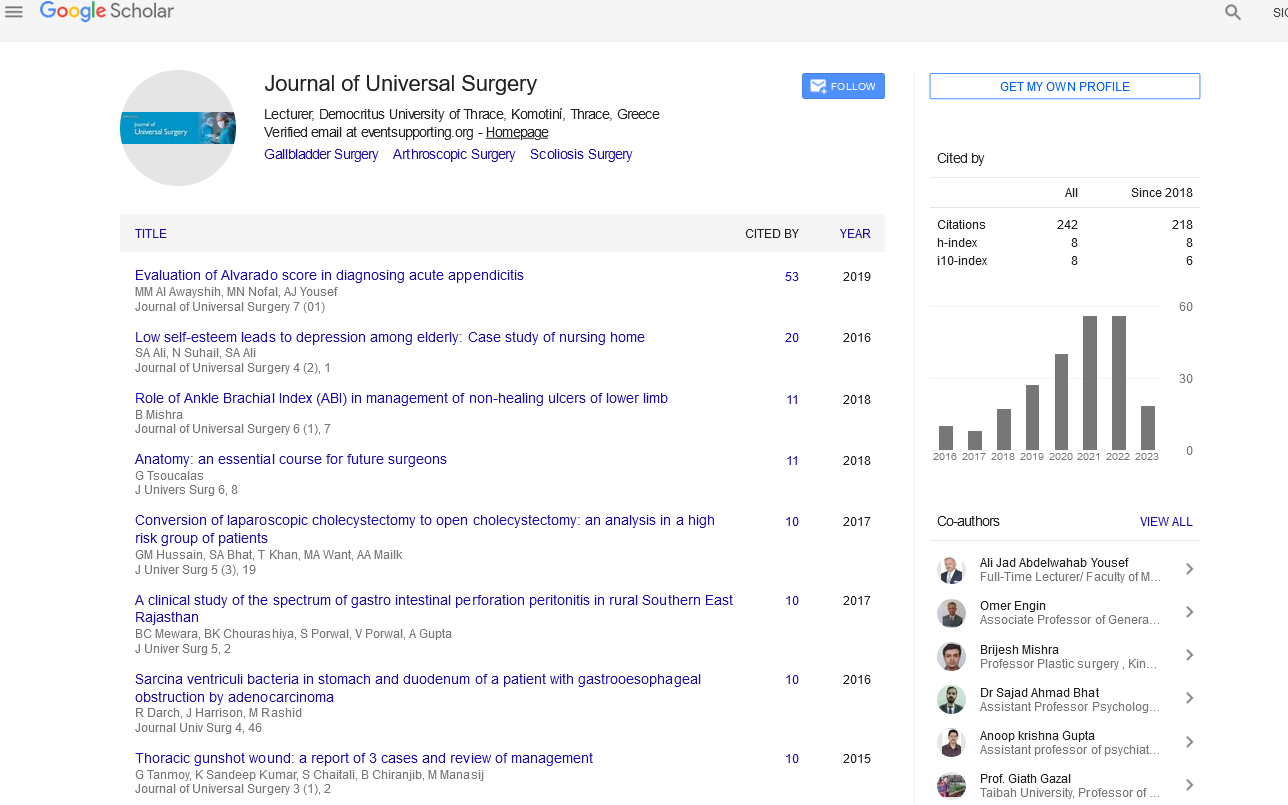Perspective - (2024) Volume 12, Issue 6
Oral Surgery Uniqueness: A Comprehensive Insight
Franklin Gray*
Department of Oral Surgeon, Central Tilba University, Central Tilba, Australia
*Correspondence:
Franklin Gray, Department of Oral Surgeon, Central Tilba University, Central Tilba,
Australia,
Email:
Received: 26-Nov-2024, Manuscript No. IPJUS-24-15368;
Editor assigned: 29-Nov-2024, Pre QC No. IPJUS-24-15368 (PQ);
Reviewed: 13-Dec-2024, QC No. IPJUS-24-15368;
Revised: 21-Dec-2024, Manuscript No. IPJUS-24-15368 (R);
Published:
29-Dec-2024
Introduction
Oral surgery is a specialized field within dentistry that blends
art and science to address complex conditions of the oral and
maxillofacial region. Unlike general dentistry, which focuses on
preventive care and basic treatments, oral surgery deals with
intricate procedures requiring precision, expertise and an
understanding of the interplay between oral health and overall
well-being. This article explores the unique aspects of oral
surgery, emphasizing its importance, complexity and evolving
innovations.
Description
Specialized scope of practice
Oral surgery encompasses a wide range of procedures, from
simple tooth extractions to reconstructive surgeries. The unique
scope of oral surgery includes:
Dental implants: Replacing missing teeth using titanium posts
that integrate with the jawbone.
Orthognathic surgery: Correcting jaw irregularities to improve
function and aesthetics.
Temporomandibular Joint (TMJ) surgery: Treating disorders
of the jaw joint and associated muscles.
Cleft lip and palate repair: Restoring functionality and
appearance in patients with congenital deformities.
Cancer treatments: Removing tumors and reconstructing
affected areas in oral cancer patients.
This diversity requires oral surgeons to possess not only
dental expertise but also surgical acumen.
Integration with other medical fields
Oral surgery stands out due to its overlap with other medical
disciplines, such as:
Otolaryngology (ENT): Addressing conditions like obstructive
sleep apnea and sinus issues.
Plastic surgery: Assisting in facial reconstructions for trauma
or congenital anomalies.
Oncology: Playing a role in head and neck cancer
management.
Neurology: Collaborating in cases involving nerve damage or
chronic pain syndromes.
This interdisciplinary nature makes oral surgery a linchpin in
comprehensive patient care.
Precision and expertise
Oral surgery demands a high degree of precision. The oral and
maxillofacial region is complex, housing critical structures such
as:
Nerves: Including the inferior alveolar and lingual nerves,
requiring careful navigation to avoid damage.
Blood vessels: Managing bleeding in a highly vascular area
necessitates meticulous surgical control.
Soft and hard tissues: Achieving seamless integration
between gums, bone and prosthetics requires skill and
attention to detail.
Such complexity underscores the uniqueness of oral surgery
in terms of its technical demands.
Advancements in technology
The uniqueness of oral surgery is also reflected in its adoption
of cutting-edge technology, enhancing accuracy and patient
outcomes:
Digital imaging and planning: 3D imaging systems like CBCT
(Cone Beam Computed Tomography) allow precise diagnosis and
treatment planning.
CAD/CAM technology: Computer-aided design and
manufacturing enable custom implants and prosthetics.
Laser surgery: Minimizing tissue damage and accelerating
healing.
Robotics: Increasing precision in complex procedures like
orthognathic surgery.
These innovations highlight the forward-thinking approach of
oral surgeons.
Patient-centric approach
Oral surgery often addresses conditions that impact a
patient’s quality of life, such as pain, aesthetic concerns or
functional impairments. Surgeons must consider:
Psychological aspects: Helping patients manage anxiety
associated with oral surgeries.
Aesthetic outcomes: Ensuring procedures like implants and
reconstructions align with the patient’s expectations.
Long-term benefits: Emphasizing the functional and health
advantages of procedures, such as improved mastication,
speech and overall oral health.
This focus on holistic patient care distinguishes oral surgery
from other dental and surgical fields.
Challenges in oral surgery
The unique challenges faced by oral surgeons further define
the field:
Anesthesia management: Balancing safety and comfort
during procedures.
Infection control: Preventing complications in a region prone
to bacterial contamination.
Healing complexities: Addressing delayed healing or rejection
of implants in certain patients.
Ethical considerations: Navigating decisions in cases involving
high risks or uncertain outcomes.
These hurdles require oral surgeons to combine technical
expertise with problem-solving and compassionate care.
Cultural and societal impacts
Oral surgery's impact extends beyond clinical practice,
influencing societal perceptions of health and beauty. For
instance:
Restorative aesthetics: Surgeries that enhance smiles and
facial symmetry contribute to improved self-esteem and social
interactions.
Access to care: Addressing disparities in oral health access,
particularly in underserved populations.
Education and advocacy: Promoting oral health awareness
and preventive measures to reduce the need for invasive
procedures.
Such contributions reinforce oral surgery's unique role in
advancing public health:
Future directions
The uniqueness of oral surgery is further underscored by its
dynamic evolution. Emerging trends include:
Regenerative medicine: Exploring tissue engineering and
stem cell applications for bone and gum regeneration.
Artificial intelligence: Enhancing diagnostic accuracy and
treatment planning.
Telemedicine: Expanding access to consultations and followup
care.
Minimally invasive techniques: Reducing patient discomfort
and recovery time.
These advancements promise to redefine the possibilities of
oral surgery, making it an even more integral part of healthcare.
Conclusion
Oral surgery is a distinctive and multifaceted discipline that
bridges the gap between dentistry and medicine. Its unique
blend of technical precision, interdisciplinary collaboration and
patient-centered care makes it indispensable in addressing
complex oral and maxillofacial conditions. As technology and
techniques continue to evolve, oral surgery remains at the
forefront of innovation, ensuring better outcomes and improved
quality of life for patients worldwide.
Citation: Gray F (2024) Oral Surgery Uniqueness: A Comprehensive Insight. J Univ Surg Vol.12 No.6: 060.





